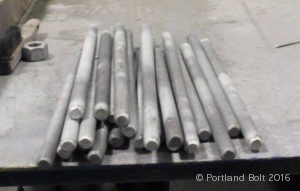All thread rod is commonly available in plain steel, hot-dip galvanized and zinc plated. Plain steel is also referred to as “black” and it is raw, uncoated steel.
Galvanizing
 Depending on the all thread rod application, the rods may need to be hot-dip galvanized if they are being exposed to the outside elements. Hot-dip galvanizing provides a thick, corrosion-resistant zinc coating to the rods and provides longevity, durability and a more economical coating in comparison with other forms of corrosion-resistant plating.
Depending on the all thread rod application, the rods may need to be hot-dip galvanized if they are being exposed to the outside elements. Hot-dip galvanizing provides a thick, corrosion-resistant zinc coating to the rods and provides longevity, durability and a more economical coating in comparison with other forms of corrosion-resistant plating.
Galvanizing all thread rod can be a difficult feat, so it is important to have the rods galvanized in a system that is specifically designed for threaded fasteners. Large galvanizing plants that are designed for larger steel structures often do not possess systems to adequately spin excess zinc off of fasteners which will likely lead to a buildup of zinc in the threads of the all thread rod. This will cause major complications in the field when the nuts do not fit properly onto the all thread rod. With that said, the process of hot-dip galvanizing fasteners is not only based on the type of dipping the system does, but the cleaning and preparation processes are equally important to ensure the best final product.
ASTM F2329 is the specification that covers fasteners that are spun in a centrifuge to remove excess zinc. F2329 is a newer and more appropriate hot-dip galvanizing specification than ASTM A153 Class C which it has essentially replaced. ASTM F2329 does not allow for the chasing of threads after galvanizing, so it is essential that all thread rod is processed in a specialized system that will galvanize the product without the need to chase excess zinc from the threads.
Preparation and Cleaning
- The rods are placed in a caustic soda solution for a period of time to remove any organic materials and oils that have come in contact with the rods during the manufacturing process. The rods are then rinsed in water.
- Following the caustic soda bath, the rods are plunged into sulfuric acid which removes scale and etches the steel allowing the zinc to physically penetrate the surface layer of the rods. After the acid bath, the rods are rinsed with water a second time.
- The last stage of preparation requires the rods be immersed in a flux solution which assists the reaction of zinc bonding to the steel.
Hot-dip Galvanizing
- The process of dipping the rods into the 840 degree molten zinc involves loading them into baskets or racks and fully submerging the rods into the zinc tank for a certain amount of time. The timing depends on the diameter of material, grade of steel and other factors. During the galvanizing process, the molten zinc metallurgically bonds to the steel.
- Cranes are used to lift the rods out of the molten zinc which are then spun in a high-speed centrifuge in order to remove excess zinc from the threads. This is the key process that produces the highest quality of galvanized all thread rod and allows for a proper nut fit.
Inspection and Packaging
- After the excess zinc is spun from the threads, the threaded rods are dumped into a water bath to cool the fasteners so they can be handled immediately.
- The rods are then inspected to ensure the fasteners will receive a nut properly and then packaged for shipping.
Zinc Plating
Zinc plating, covered by ASTM specification F1941, is a much different coating in comparison to hot-dip galvanizing. Zinc plating is an electroplating process where the zinc is applied to the steel by using a current of electricity. This coating is thin and can be nicked in the handling of the rods which could lead to weak points in the coating and could cause rust. It is not typically a suitable coating for outdoor use, however, it does have some advantages that hot-dip galvanizing does not. The coating is typically more aesthetically appealing because of the brightness and uniform color. There are also different colors of zinc plating such as clear which is a shiny silver, yellow and black.
Other Coatings
All thread rods can be coated with a number of other plating and coating options which are less common such as cadmium, Xylan, PTFE, zinc-aluminum, mechanical galvanizing, black oxide coating, powder coating and various other coatings. For questions on different types of coatings for all thread rod, please contact me.
